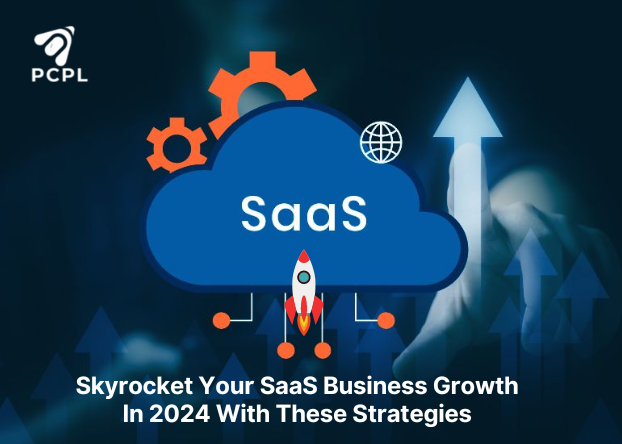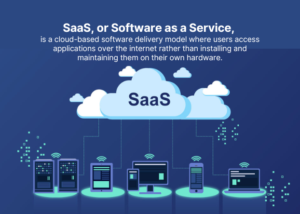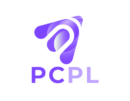
Skyrocket Your SaaS Business Growth In 2024 With These Strategies
The SaaS industry is booming, with the global market expected to reach a massive $702.19 billion by 2030. What’s driving this growth, and how can businesses tap into its potential to build sustainable businesses?
The SaaS landscape is more competitive and innovative than ever before in the current times. To ensure your SaaS business thrives, it’s crucial to focus on growth strategies that align with emerging trends, customer expectations, and technological advancements.
What is SaaS?

SaaS transforms the traditional software model by offering flexibility, accessibility, and cost-efficiency. Businesses don’t need to worry about software updates, security patches, or hardware compatibility—everything is managed by the service provider, ensuring that users always have access to the latest features and tools.
Measuring SaaS Growth
Measuring the growth of a SaaS business is crucial for evaluating its success and identifying areas for improvement. Several key performance indicators (KPIs) can help track the progress and health of your SaaS company.
Important metrics to focus on
- Monthly Recurring Revenue (MRR)
MRR is the lifeblood of any SaaS business. It tracks the consistent revenue generated from subscription-based customers each month.
- Customer Acquisition Cost (CAC)
CAC measures how much it costs your business to acquire a new customer. It includes marketing, sales, and other expenses involved in the customer acquisition process.
- Customer Lifetime Value (CLTV or LTV)
LTV estimates the total revenue a business can expect from a single customer throughout their entire relationship with the company. A high LTV means your customers are staying longer and contributing more to your revenue.
- Churn Rate
Churn rate is the percentage of customers who cancel their subscription over a given time frame. High churn rates can cripple SaaS growth, making it essential to keep this metric in check.
- Net Revenue Retention (NRR)
NRR calculates the percentage of recurring revenue retained from existing customers after accounting the upgrades, downgrades, and churn. It reflects the ability to grow revenue from your current customer base, even without acquiring new customers.
- User Engagement Metrics
Tracking how customers are engaging with your product can provide insights into growth potential. Metrics like daily active users (DAU), monthly active users (MAU), and product usage frequency help determine if customers are finding value in your software.
- Lead Velocity Rate (LVR)
LVR measures the growth rate of your qualified leads from one month to the next. It provides a forward-looking view of how quickly your sales pipeline is growing.
- Average Revenue Per User (ARPU)
The average amount of revenue that is generated per user is termed as ARPU. Tracking this metric over time can show whether your pricing strategy is effective and if there are opportunities to increase revenue through upselling or premium offerings.
- Sales Cycle Length
The sales cycle length measures how long it takes to close a deal, from the first contact with a potential customer to the final sale. Reducing the sales cycle can help increase the velocity of growth, as it allows you to close more deals in a shorter amount of time.
- Customer Satisfaction and NPS (Net Promoter Score)
NPS measures customer loyalty by asking how likely your customers are to recommend your SaaS product to others. A high NPS score indicates customer satisfaction and can lead to organic growth through referrals.
Strategies to propel your SaaS business to new heights in the coming days

- Refine Your Product-Market Fit
Your SaaS product needs to solve a significant pain point for your target audience. Conduct market research regularly to refine your product-market fit and align your solution with evolving customer needs. Implement feedback loops with your users to continually improve your product and stay relevant in a competitive environment. Knowing the exact needs of your customer helps you fine-tune your features and keep ahead of the competition.
- Focus on Customer Success
In SaaS, customer retention is just as important—if not more so—than acquisition. Offering excellent customer support and implementing a solid customer success strategy is crucial to reduce churn rates. Help your customers achieve their goals using your software by providing proactive onboarding, training, and continuous support. The better the experience customers have, the more likely they are to remain loyal and recommend your product to others, driving organic growth.
- Adopt a Usage-Based Pricing Model
Traditional subscription pricing models are giving way to more flexible usage-based models. This approach allows customers to pay based on how much they use your service, creating more cost-effective and scalable options for businesses of all sizes. A usage-based model can increase customer satisfaction, as users feel they are only paying for what they need. It also provides opportunities for upselling as customers scale their usage over time.
- Make use of Product-Led Growth (PLG)
A product-led growth strategy empowers your software to drive acquisition, conversion, and retention by focusing on the user experience. Offer free trials, freemium models, or limited-access versions that showcase the value of your product. By letting potential customers experience your software’s benefits firsthand, you can shorten sales cycles and encourage self-service adoption. SaaS companies like Slack and Zoom have successfully employed PLG strategies to fuel viral growth.
- Optimize Your Sales Funnel for B2B SaaS
Many SaaS businesses cater to B2B clients, and optimizing your sales funnel is essential for closing deals faster. Understand the different stages of your sales funnel and customize content and outreach at each step to nurture prospects effectively. Use CRM tools and marketing automation to track leads, score them based on engagement, and push them toward conversions more efficiently. Personalization is key here—tailor your messages to specific industries or decision-makers.
- Prioritize Data-Driven Decision Making
To stay competitive in 2024, make data a cornerstone of your business strategy. Leverage analytics tools to gather insights about your customer behavior, product performance, and marketing campaigns. Use this data to refine your approach, optimize pricing, and predict customer needs. SaaS companies that are data-driven are more agile and able to spot opportunities for growth and improvement quicker than their counterparts.
- Build Strong Partnerships
Collaborating with complementary service providers or joining ecosystems within your industry can be a game-changer for scaling your SaaS business. Strategic partnerships open up new channels for customer acquisition, foster innovation, and give you access to larger markets. Whether through API integrations, reselling agreements, or co-marketing efforts, forming alliances can significantly boost your visibility and credibility.
- Invest in SEO and Content Marketing
High-quality content and SEO should be at the forefront of your marketing strategy. SEO can be one of the most cost-effective ways to attract new users to your product over the long term. Invest in creating valuable, relevant content that addresses your customers’ pain points and provides solutions. A blog, whitepapers, case studies, and customer testimonials not only improve your search rankings but also establish your brand as an authority in your field.
- Automate Where Possible
Automation is key to scaling a SaaS business. Implementing automation across your operations—from customer service to marketing—can free up time for your team to focus on growth-related activities. Use AI-driven chatbots for customer support, marketing automation platforms for personalized outreach, and automated billing solutions to ensure smooth and efficient processes. Automation will not only help you scale faster but also improve customer satisfaction.
- International Expansion
If you’ve reached saturation in your local market, consider expanding internationally. In 2024, the global SaaS market is booming, and with the right approach, you can tap into new revenue streams by reaching customers in untapped regions. Adjust your marketing strategy to different cultural contexts, offer multilingual support, and ensure your product is compliant with international laws and regulations.
- Build a Community Around Your SaaS
Building a strong community around your product can amplify your brand’s reach and foster customer loyalty. Communities can take the form of online forums, user groups, or social media groups where users can interact, share tips, and provide feedback. A thriving community not only drives customer engagement but also helps in gathering user-generated content and insights for product improvement.
- Enhance Mobile Accessibility
With more users accessing SaaS products via mobile devices, ensuring that your platform is mobile-friendly is vital for growth in 2024. A mobile-optimized user interface (UI) and user experience (UX) are non-negotiable, especially as remote work and on-the-go solutions become more prevalent. Focus on mobile optimization to cater to a wider audience and provide a seamless experience across devices.
Success Story of Slack
Slack, one of the most successful SaaS companies of the past decade, followed a systematic and highly effective approach to scaling its business using principles that align with the Five-Star SaaS Growth Framework.
- Product-Market Fit
From its inception, Slack focused on addressing a core problem—communication and collaboration within teams. It identified a pain point in the workplace: inefficient internal communication and the fragmented use of different tools. Slack’s approach to product-market fit was guided by user-centric development. The company built a product that was easy to use, integrated with other essential workplace tools, and could adapt to teams of various sizes. Its real-time messaging platform quickly became an essential part of the daily workflow for companies across industries.
Slack’s strategy was to offer a freemium model that allowed users to experience the product before committing to paid plans. By allowing users to derive value before any financial investment, Slack rapidly achieved viral growth, which is a hallmark of strong product-market fit.
- Customer Success
Slack put a major emphasis on customer success from the start, ensuring users could easily adopt and find value in the platform. The company invested in a comprehensive onboarding experience that guided teams on how to best use Slack for collaboration, saving time and improving productivity.
One of Slack’s key moves in customer success was making it incredibly easy for teams to integrate their workflows into Slack, with seamless integrations with other popular SaaS tools like Google Drive, Trello, and Salesforce. This made Slack more valuable for users and encouraged longer-term engagement.
Slack continuously improved its product and support services, by maintaining an active customer feedback loop, thus leading to high customer satisfaction and loyalty. This focus on customer success contributed to low churn rates and high customer retention.
- Sales Efficiency
Although Slack started as a product-led growth (PLG) company, where users could sign up, experience the product, and convert on their own, it also developed a sales team for enterprise-level accounts. Slack understood that while smaller teams could adopt the product independently, larger organizations often needed a more hands-on approach.
Slack’s sales efficiency came from its ability to leverage user-generated demand to land and expand. Many enterprise sales were initiated by smaller teams within a company using the free version of Slack. As adoption grew organically within these organizations, the Slack sales team would step in to offer enterprise solutions and negotiate bulk licenses, making it easier for companies to scale their use of the product.
- Revenue Expansion
Slack mastered the art of expansion MRR (Monthly Recurring Revenue). Its freemium model and PLG approach created a natural pathway for upselling. Small teams would start using Slack for free, and as they added more users, required more storage, or needed advanced features (like unlimited message history or enhanced security), they would upgrade to a paid plan.
Slack’s pricing model is designed to expand as companies grow. As organizations scale and new departments adopt the tool, Slack becomes increasingly essential to their daily operations. This results in higher per-user revenue and recurring upsell opportunities.
Additionally, Slack made it easy for businesses to scale up without friction by providing flexible pricing plans that matched their growth needs, further increasing lifetime value (LTV) and driving long-term growth.
- Data-Driven Decision Making
One of the core reasons for Slack’s explosive growth is its reliance on data-driven decision making. Slack tracked user behavior to understand how teams were interacting with the platform and used these insights to refine the product, add new features, and improve the user experience. This granular analysis allowed Slack to identify potential churn risks and proactively address user concerns before they escalated.
Slack also leveraged product usage data to identify upsell opportunities. For example, if a company was nearing its free message storage limit or had a high number of active users, Slack’s sales team would target that organization with an offer to upgrade, driving revenue growth through data-backed strategies.
Furthermore, data played a role in guiding Slack’s marketing and customer acquisition strategies. Slack was able to optimize its ad spend and marketing efforts to target the right audiences by tracking which channels brought in the most engaged users.
Conclusion
The SaaS industry is set to grow even more in the coming days, with new technologies, customer expectations, and business models reshaping the landscape. The growth isn’t just about acquiring new customers, it’s about nurturing them to become lifelong advocates. To achieve sustainable success, you need a strategic blend of customer acquisition, retention, and revenue optimization.
A dedicated marketing team is crucial for executing your growth strategy effectively. Consider your in-house capabilities and the benefits of partnering with an experienced agency.
We are eager to join hands with you and take your SaaS business to the next level. Our team specializes in helping businesses like yours achieve accelerated growth. Contact us today to discuss your specific needs and explore potential partnership opportunities. We’re eager to provide valuable insights and support.
